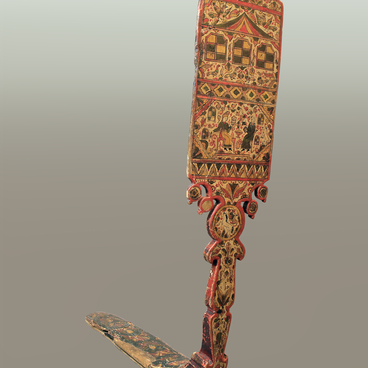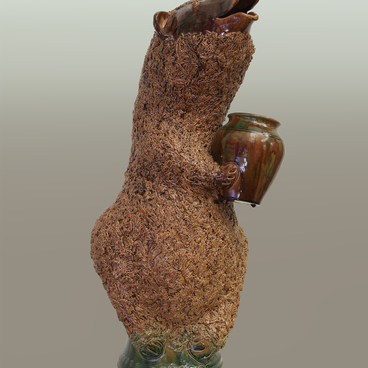In the Volga region, there were two-piece distaffs of a special design — they consisted of a base (called “dontse”) and a comb. To start spinning, the comb was inserted into a special slot, and after spinning, it was taken out and the beautiful base was proudly hung on the wall as a piece of interior décor, like a picture or a popular print.
The Gorodets style of carving appeared due to a unique local phenomenon: the winding Uzola River washed the banks, oaks fell into the water and the oak wood became especially hard due to staying in water for a long time. This rare material was dark, so bog oak inlays created a unique artistic effect, when paired with a lighter aspen base. This was how the history of the famous Gorodets craft began — it started with a complex inlay technique making use of bog oak. This technique was laborious at every stage of execution — from sawing heavy oak logs under water and lifting them ashore to the finest fitting of the silhouettes of horses, riders, birds, and dogs into specially carved niches and fixing them with small round nails made from the same bog oak.
An image of a carriage ride was one of the typical plots of the early Gorodets distaff bases. Researchers believe that its origin is associated with local Nizhny Novgorod wedding folklore and attribute it to that stage of the festive wedding ceremony when the bride traveled in a carriage to the church. The plot depicted on the base — a harnessed horse, a coachman sitting at the front of the carriage, and a woman in the window — is often present on items from museum and private collections. Attentive viewers would appreciate distaff bases with carriages featuring a unique combination of abstract stylization and accurate life observations.
The images of two riders flanking a tree with a bird are also typical for Gorodets distaff bases. This plot is also known in other types of folk art, for example, in embroidery, and is one of the oldest pictorial motifs associated with pagan symbols. Its popularity on Gorodets distaff bases can also be explained by its direct connection with local wedding folklore and songs, in which the groom chases his beautiful bride, who is compared to a bird. The common visual image of this “hunting” comes in numerous versions with a broad range of symbols in various well-known exhibits. This plot originated in carved décor and became one of the most popular scenes painted on Gorodets distaff bases.
The Gorodets style of carving appeared due to a unique local phenomenon: the winding Uzola River washed the banks, oaks fell into the water and the oak wood became especially hard due to staying in water for a long time. This rare material was dark, so bog oak inlays created a unique artistic effect, when paired with a lighter aspen base. This was how the history of the famous Gorodets craft began — it started with a complex inlay technique making use of bog oak. This technique was laborious at every stage of execution — from sawing heavy oak logs under water and lifting them ashore to the finest fitting of the silhouettes of horses, riders, birds, and dogs into specially carved niches and fixing them with small round nails made from the same bog oak.
An image of a carriage ride was one of the typical plots of the early Gorodets distaff bases. Researchers believe that its origin is associated with local Nizhny Novgorod wedding folklore and attribute it to that stage of the festive wedding ceremony when the bride traveled in a carriage to the church. The plot depicted on the base — a harnessed horse, a coachman sitting at the front of the carriage, and a woman in the window — is often present on items from museum and private collections. Attentive viewers would appreciate distaff bases with carriages featuring a unique combination of abstract stylization and accurate life observations.
The images of two riders flanking a tree with a bird are also typical for Gorodets distaff bases. This plot is also known in other types of folk art, for example, in embroidery, and is one of the oldest pictorial motifs associated with pagan symbols. Its popularity on Gorodets distaff bases can also be explained by its direct connection with local wedding folklore and songs, in which the groom chases his beautiful bride, who is compared to a bird. The common visual image of this “hunting” comes in numerous versions with a broad range of symbols in various well-known exhibits. This plot originated in carved décor and became one of the most popular scenes painted on Gorodets distaff bases.


